About the author

Malkhaz Erkvanidze
Malkhaz Erkvanidze is a world-renowned authority on Georgian traditional chant, having dedicated his life to popularizing, performing, and teaching several generations of chanters.
1. INTRODUCTION
The present paper discusses selected results from my dissertation work on “The History of Georgian Chant Notation and the Georgian Musical System” (Erkvanidze, 2014). One of the main challenges in the context of trying to understand the Georgian Musical System is the fact that no theoretical treatises have survived to this day. The main sources of our information today are the audio recordings of professional chanter-singers made over 100 years ago. Theoretical and acoustic analysis of this material are the only means to understand the old Georgian musical system and the underlying systemic thinking, or modal thinking, as we call it. This has been the focus of my research since I was a Conservatoire student.
Naturally the question arises how the musical system and systemic thinking are preserved and maintained in these recordings? For years, together with my students, I conducted experiments in the direction of singing and thinking in the original Georgian scale. I believe that both the musical system and systemic thinking are invariably preserved in the available recordings, primarily implying modal thinking. The magnificent traditions of the old Georgian schools of chant and song had been imprinted and settled in the minds and memories of the recorded performers.
A previous version of this article was published here.
2. GEORGIAN MUSICAL THINKING
It is well known among musicologists studying traditional Georgian music that Georgian musical thinking is based on tetrachords, pentachords, as well as seven and eight note scales. The largest challenges in Georgian ethnomusicology today, and a topic of intense research, are related to the attempts to understand the modal structure of the music. Although the importance of the modal structure is basically undisputed among musicologists, there is still controversial discussion on several aspects.
In this context, critical points from my perspective are the following:
- Modes and steps are often counted bottom-up and not top-down;
- The bass is often considered as determinant for mode, i.e. the mode is ascertained according to the bass either at the beginning or at the end of the song;
- The bass is often considered to direct modulations;
- Such conclusions are often drawn from transcriptions of the songs into a five-line notation system, which often does not correspond to the original sound;
- Such theories are often distanced from practice.
Based on the results of my research, which will be further detailed below, I have come to the conclusion that the Georgian system is different; it is based on thinking of music in a descending manner.
It resembles the Ancient Greek descending modal system, where the basic mode is obtained from two ways of binding two tetrachords: “interlocked” and “separated”. Modal formations of higher quality came into existence as tetrachord combinations. There were two principles of combination: interlocked – with the coincidence of adjacent sounds in tetrachords and separate – with adjacent sounds distanced by a whole tone” (Kholopov, 1975: 30). In this context, see also the discussion of the descending nature of Georgian modes by Kakhi Rosebashvili discussed (Rosebashvili, 1988).
The discovery of the 3500-year-old tongueless salamuri flute in Mtskheta is the earliest evidence for the existence of a musical system in Georgia. The tongueless salamuri is a unique instrument from the perspective of musical acoustics; different tetrachords are formed by inclining the instrument. Particularly interesting is the modulation on the salamuri. The basic scale of the instrument is the descending tetrachord; it should be noted that this tetrachord is the same as the basic upper tetrachord of the general scale discovered by us, but with a distinctive character: with the elevated II and lowered III steps. The eight-step scale manifested in the polyphonic modal system could have been formed based on the descending tetrachord (Ex. 1).

Example 1. Scale of Salamuri flute and modal modulation on the Salamuri.
Particular mention should be made of several circumstances. In Georgian musical thinking, modes, as well as the principle of harmonization, are conceptualized downward. As a consequence of this, the mode should naturally be determined top-bottom and not vice versa. The bass functionally is derived from the top voice, but at the same time the bass establishes the stability of the mode. During modulation (apart from rare exceptions, especially in folk songs), it does not initiate the process but acts according to the upper voices, particularly the top voice-part. In chanting, it operates strictly from the top voice, but in folk music either from mtkmeli or modzakhili, depending on the case. I would also like to add that the bass is always ready for modulation, as it always knows in advance when the modulation is going to happen, as the bass singer also knows both top and middle voice-parts (in the old times every performer knew all voice-parts).
The analysis of the audio material revealed that Georgian chant thinking is based on an eight-degree scale according to the two methods for binding tetrachords into a scale, which I refer to as merged and split scales. Otherwise, this is one scale which implies two in itself. In this context two modes can coexist: one of them is basic, the other one auxiliary. There are cases when only one scale with one mode is standing out. I have observed that both modes are equally present in chants.
In a large number of Georgian chants and songs, with the two ways of tetrachord binding (merged and split), Georgian scales outwardly resemble old Greek ones. When discussing the old Greek modal system, Kholopov and Herzman correctly consider modal steps from Nete to Hipate (Kholopov, 19 : 306; Herzman, 1986: 29). Sulkhan-Saba Orbeliani provides similar explanation: “Hipatoi and Nita are strings tuned from zili to bokhi” (Orbeliani, 1991: 594). Such an explanation by the lexicographer underlines the descending nature of musical thinking, i.e. from zili to bokhi (zili is the top string of the instrument, while bokhi is the bottom one).
What is the principal difference between the old Greek and Georgian descending modes? As a consequence of the fact that Georgian musical thinking is polyphonic and Georgian polyphony is constructed on fourth-fifth-octave parallelism, at one time tetrachords were evidently divided with the consideration of this type of polyphony, namely:
a) by avoiding the tritone (the existence of a tritone as augmented fourth or diminished fifth was inadmissible at the time), at the same time by the maintenance of interval features by fourth and fifth; and
b) to achieve modal diversity by displacing the centers of upper steps of the mode (Ex. 2).


Example 2. Top staff: Basic mode with two tetrachords interlocked mode. Bottom staff: Accomplished system.
See also the chart illustrating interval conformity in the Appendix (Fig. A1). If the distance between the sounds of the Georgian systemic scale changes by a few cents, everything will become mixed together. It is remarkable that during singing the old masters accurately follow this modal thinking and system.
Based on the studied material we suppose that there are six ways for tuning the chonguri (Ex. 3).

Example 3. Six different tunes of the chonguri.
Malkhaz Erkvanidze demonstrating the Georgian scale in three-voiced contexts
3. EVIDENCE FOR THE TOP-DOWN STRUCTURE OF THE MODAL SYSTEM
As mentioned above, the Georgian mode is descending. There is a huge difference between ascending and descending modes, expressed in conceptual categories. For instance, if we compare the ascending Dorian mode with the Georgian descending double-tetrachord split mode we can see that both have a similar modal character (Ex. 4).
![]()

Example 4. Top staff: ascending Dorian mode. Bottom staff: descending double-tetrachord split mode.
The main aspect here is that the two modes have different reference points: the bottom degree I for the ascending and the top degree I for the descending type. The ascending Dorian mode is generally considered to be of a minor character and indeed this is so; as for the Georgian descending split mode, which resembles the Dorian mode at first glance, the picture is absolutely different. In the descending Georgian mode songs and chants are mostly interpreted as of major character with the consideration of the central I degree. This is determined by the existence of the upper degree as center (Ex. 5).

Example 5. The Georgian Major character of Dorian mode in double-tetrachord separated mode.
For more clarity, all examples in the paper are presented in one mode-tonality with the consideration of corresponding degrees. In support of the conclusion that the mode is determined not by the bass or lower support, but by degree I, below are three examples of Kriste aghdga (Ex. 6).
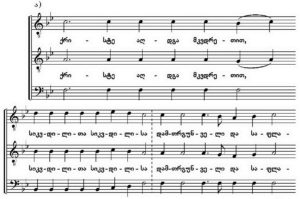

Example 6a. The chant Kriste Aghdga (Christ Is Risen) in Kartli-Kakhetian simple mode (Erkvanidze, 2014a: 267).

Example 6b. The chant Kriste Aghdga (Christ Is Risen) as performed by Artem Erkomaishvili. Preserved at the Archive of the Georgian Musical Folk Laboratory of Tbilisi State Conservatoire.
Example 6c. The chant Kriste Aghdga (Christ Is Risen) in the version of Benia Mikadze (Erkvanidze, 2004: 147).
Let us look carefully. The first part is the same in all three cases, but in the beginning of the first variant the bass enters the fifth, whilst in the second variant it enters the octave, and in the third variant, the ninth. Does this not mean that in all three cases we have different modes? Indeed, this would be the conclusion based on the current perspective of many in ethnomusicologists. However, I believe that the determination of the mode from the bass will not lead to logical conclusions. In the presented examples it seems obvious that the mode is determined from by the top voice with its centre on degree I which directs and determines the mode.
Here we have an example of the old method of vocal tuning according to which in chanting and singing the bass tunes with the first voice, sometimes in a fifth, sometimes in an octave, but in West Georgia, particularly in the Gurian tradition, in a ninth. This is a usual occurrence. If in the three aforementioned cases of Kriste aghdga, we would determine the modes according to bass we would come to the conclusion that there are three different modes on the same melody. I definitely believe that this is wrong. In this particular case we have a double-tetrachord split mode with the consideration of the centrality of the upper step and different ways for the harmonization of bass.
4. MODULATIONS
Some remarks on modulations within the Georgian modal system. If F is conditionally considered as a basic mode-tonality, then G and E flat are considered closely kindred tonalities (Ex. 7).
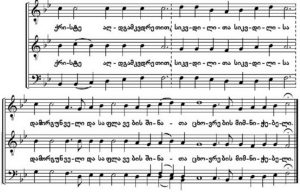
Example 7. Basic mode-tonality and related closely and distant kindred tonalities. Modulations in closely kindred tonalities (from F to G and E).
Here is one obvious example of modulation activity in the Georgian modal system, the chant Tsmindano motsameno, where two mode-tonalities have only one shared pitch (notably, while this single pitch is common, its function is not), but the rest are different (Ex. 8).

Example 8a. The chant Tsmindano motsameno (Ye holy martyrs) as performed by Artem Erkomaishvili. Preserved at the Archive of the Georgian Musical Folk Laboratory of Tbilisi State Conservatoire.
Example 8b. The tones of the F mode-tonalities.
Example 8c. The tones of the G mode-tonalities.
Example 8d. The correlation between the steps during the modulation.
This is exactly what Ioane Batonishvili discusses in “Kalmasoba” (early 1800s source text): “The kankledi, also called shinpardi, only slightly differs from mode; it is used the same way with an instrument as with chant in the eight-tone system” (Bagrationi, 1991: 524). I believe that kankledi and shinpardi imply modulation.
Noteworthy here is that in the European functional system, modulation is realized via a modulating chord, whilst in the Georgian modal system this happens either via a modulating sound or direct transition. In the case of mode-tonal modulation one tone upward or downward, only one sound remains common, while the other 7 change. As an example of modulation into distant tonalities related to F mode-tonality, here I provide the modulation schemes from F to A flat mode-tonalities via E flat mode-tonality (Ex. 9).

Example 9. Modulation to the distant mode-tonalities ( from F to As and Es) and the tones of the As and Es mode-tonalities (bottom staffs).
For an example of such modulation, see the chant Ganatldi and the Rachan song Maqruli (Ex. 10).
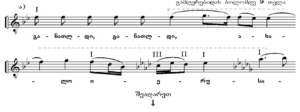
Example 10a. The Chant Ganatldi, ganatldi (Shine, Shine O New Jerusalem) as performed by Artem Erkomaishvili. Preserved at the Archive of the Georgian Musical Folk Laboratory of Tbilisi State Conservatoire.
Listen to an audio recording of the chant “Ganatldi, ganatldi (Shine, Shine O New Jerusalem) as recorded by Artem Erkomaishvili in 1966.
Example 10b. The Rachan folk song Maqruli, from the field expedition of Chkhikvadze-Grimaud, 1967. Transcribed by M. Erkvanidze. Preserved at the Archive of the Georgian Musical Folk Laboratory of Tbilisi State Conservatoire.
Please note that of these two examples, one is a chant and the Maqruli is a song. The first stanzas of both examples are identical in terms of modulation and structure, which emphasizes the unity of modal thinking among both the chant and song repertories.
5. MODAL THINKING
In Georgian polyphonic chant practice, diversity is created not by different modes with corresponding centers (as in the Greek eight-tone system), but by stanzas with different modal characters similar to the eight-tone system. For instance, the stanza starting on degree I and ending on degree IV has the character of a major scale, but the one starting on degree I and ending on degree III has a minor character. As an example, we provide several five-step phrases on different degrees within a single mode-tonality (Ex. 11).

Example 11a. The chant Daghatsatu nebsit tvisit (Though thou didst descend) as performed by Artem Erkomaishvili. Preserved at the Archive of the Georgian Musical Folk Laboratory of Tbilisi State Conservatoire.
Example 11b. The chant Mtasa zeda peristsvale kriste (Thou wast transfigured). Preserved at the Archive of the Georgian Musical Folk Laboratory of Tbilisi State Conservatoire.

Example 11c. The Christmas IV Heirmos Kvertkhi ieses dzirisagan (The Rod of the Root of Jesse) as performed by Artem Erkomaishvili. Preserved at the Archive of the Georgian Musical Folk Laboratory of Tbilisi State Conservatoire.

Example 11d. The IX Heirmos Saidumlo utskho (A Mystery strange) as performed by Artem Erkomaishvili. Preserved at the Archive of the Georgian Musical Folk Laboratory of Tbilisi State Conservatoire.
As we see, these stanzas have different modal characters, but this does not necessarily mean that they belong to different modes and mode-tonalities. Here we have one F (in this case) mode-tonality and an arrangement of stanzas on different steps within this mode-tonality.
Similar stanzas are on the same degrees of the mode, which determines stability and order in musical material. A number of chant and song examples are bound not according to a particular melody, but mostly by the unity of different stanzas. Thus, for example, the same chant may consist of different stanzas in East and West Georgia.
A playlist of all of the Artem Erkomaishvili recordings, including the above-cited chant examples:
6. CONCLUSIONS AND OUTLOOK
The chief goals of my research and practical work are to:
- Understand three-part and polyphonic thinking in general;
- Master modal thinking;
- Sing in traditional scale and to revive medieval sound;
- Think with parallel stanzas in chant and song;
- Understand how to differentiate stylistic-harmonious peculiarities;
- Master a diversity of traditional performance manners;
- Revive systemic thinking in general;
- Solve the enigma of the dasdebeli.
The focus (and novelty) of my research is on deciphering the Georgian polyphonic musical system, allowing us to conceptualize our ancient music. I hope that in the long run this will lead to the following:
- A revival of the original Georgian modes and scales, allowing us to perform thousands of chants in the original way. In this context, singing modally is particularly important, as this contains the treasures of the Georgian musical language.
- A revival of the musical system, allowing us to make correct and valuable scientific conclusions on issues such as mode, modulations, scales, instrument tunings, eight-tone system, etc.
- A revival of musical systems, implying the revival of modal thinking i.e. the performer knows in which mode the chant or song was started and finished (in the case of modulation), what kind of modulation was applied, and where the musical construction was moved.
- The preparation of text-books of Georgian solfegio and harmony, allowing the students to become accustomed to correct Georgian musical thinking; such manuals have never yet been prepared.
- The enabling the revival of the oral tradition of learning chants and song. I apply this method practically at the High School; after completing the preparatory period in vocal tuning, students can study all three parts of a chant in an oral way with the help of neumes in 15-20 minutes. This practically means that the old method of teaching has been achieved.
One of the most significant issues of Georgian musical thinking is performance in the correct manner. This has survived invariably in old authoritative records. They allowed reviving the sound system, guaranteeing the mastery of correct performance manner.
7. REFERENCES
Batonishvili, Ioane. (1991). Kalmasoba. Vol . II, Tbilisi: Merani.
Erkvanidze, Malkhaz. (2014). Kartuli galobis notebze gadaghebis istoria da kartuli samusiko sistema (The History of Georgian Chant Notation and the Georgian Musical System). Doctoral dissertation (manuscript copyright). Preserved at the library of Georgian Folk Music Department of Tbilisi State Conservatoire.
Gertsman, Evgeny. (1986). Antichnoe muzikalnoe mishlenie (Antique Musical Thiking). Leningrad: Muzika. (In Russian)
Orbeliani, Sulkhan-Saba. (1991). Leksikoni kartuli (Georgian Lexicon); vol. 1. Tbilisi: Merani. (In Georgian)
Kholopov, Yuri. (1975). Drevnegrecheskie ladi (Ancient Greek Modes). In: Muzikalnaya entsiklopediya (Music Encyclopedia),vol. II. Pp. 306_307. Moskva: Sovetskaya entsiklopedia.
Rosebashvili, Kakhi. (1988). “Kartuli khalkhuri simgheris kilos gansazghvris sakitkhisatvis (aghmosavlet sakartvelos khalkhuri simgherebis magalitze)” (“On the Definition of the Mode in Georgian Folk Song (On the Example of East Georgian Folk Songs)”). In: Kartuli musikis poliponiis sakitkhebi (Issues of Georgian Polyphony); pp.: 42_61. Editors: Gabunia, Nodar, Tsurtsumia, Rusudan and at al. Tbilisi: Tbilisi State Conservatoire. (In Georgian)
8. NOTATED COLLECTIONS
Erkvanidze, Malkhaz (comp.). (2006). Kartuli saeklesio galoba, t. IV (Georgian Church Chant, vol. IV). Tbilisi: Center for Chant of the Georgian Patriarchy.
Erkvanidze, Malkhaz (comp.). (2008). Kartuli saeklesio galoba, t. V (Georgian Church Chant, vol. V). Tbilisi: Center for Chant of the Georgian Patriarchy.
Erkvanidze, Malkhaz (comp.). (2014a). Georgian Church Chant, East Georgian School (Karbelashvili Mode), Hymns of the Twelve Feasts of Our Lord, the Immovable Feasts, the Lenten Triodion, and the Pentecostarion. Vol. VII. Tbilisi: Center for Chant of the Georgian Patriarchy.
Koridze, Philimon (comp.). (1895). Kartuli galoba, partitura 1 (Georgian Chant, Score 1). Tpilisi: M. Sharadze’s publishing and typography. (In Georgian)
Shughliashvili, Davit. (2002). Kartuli saeklesio galoba. Shemokmedis skola (Georgian Sacred Chant. Shemokmedi School). Tbilisi: Center for Chant of the Georgian Patriarchy.
9. APPENDIX
Fig. A1. Interval conformity in cents.








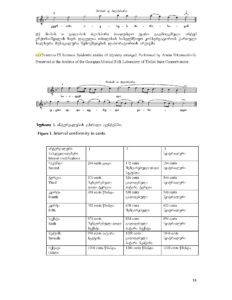
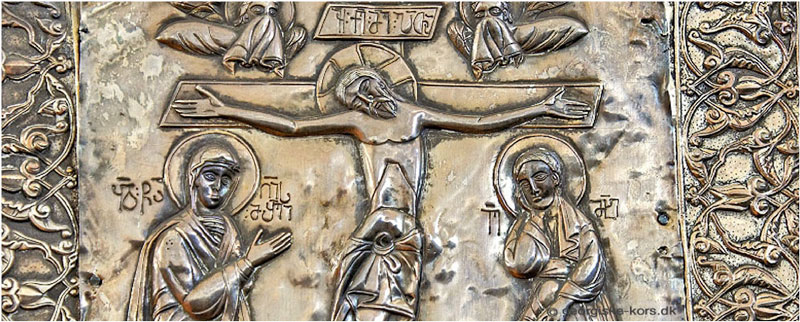

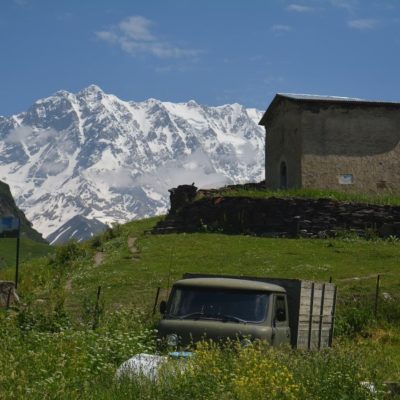

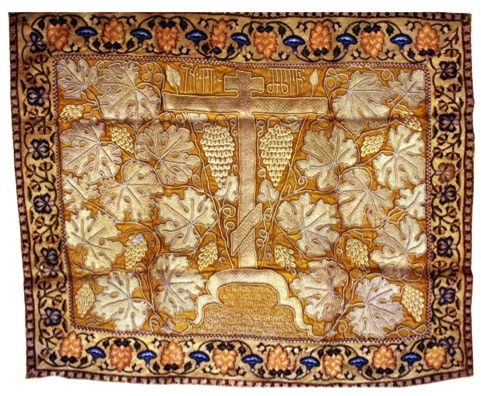
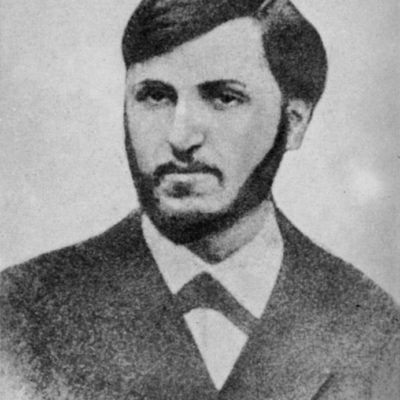
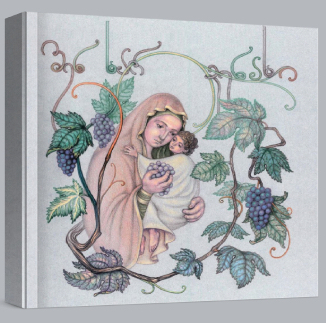
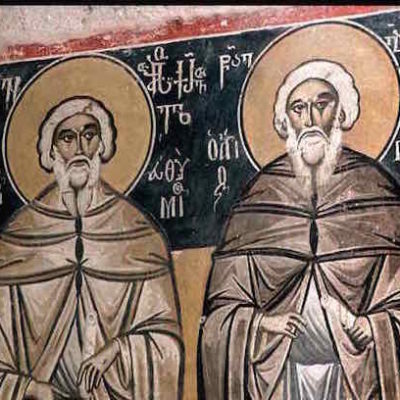
Leave a Reply